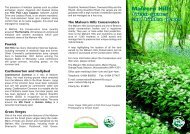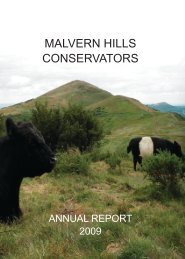Footpath degradation of the Malvern Hills - Malvern Hills Conservators
Footpath degradation of the Malvern Hills - Malvern Hills Conservators
Footpath degradation of the Malvern Hills - Malvern Hills Conservators
Create successful ePaper yourself
Turn your PDF publications into a flip-book with our unique Google optimized e-Paper software.
Stephen Britnell<br />
<strong>Footpath</strong> <strong>degradation</strong> <strong>of</strong> <strong>the</strong> <strong>Malvern</strong> <strong>Hills</strong><br />
significant if <strong>the</strong> degree <strong>of</strong> variance <strong>of</strong> points from <strong>the</strong> line <strong>of</strong> regression on a graph is low.<br />
Significant results in Table 3 are in bold Italics.<br />
Figure 8 shows <strong>the</strong> location and rating <strong>of</strong> footpaths along <strong>the</strong> <strong>Malvern</strong> <strong>Hills</strong>. Path<br />
sections with a rating <strong>of</strong> 1 have a high amount <strong>of</strong> erosion, 2 suffer moderate path erosion, and<br />
3 low path erosion and are stable. The <strong>Malvern</strong> <strong>Hills</strong> are broken down into three hill zones,<br />
nor<strong>the</strong>rn, central, and sou<strong>the</strong>rn. These separate zones are situated in a straight line running<br />
from north to south. They are arranged in an L-shape on <strong>the</strong> map for convenience <strong>of</strong> display.<br />
5. Discussion<br />
In this section I will be discussing causal <strong>the</strong>ories, <strong>the</strong> degree <strong>of</strong> correlation between<br />
relationships and <strong>the</strong> relative importance <strong>of</strong> variables. The main <strong>the</strong>ories looked at will be, i)<br />
recreational pressure acts positively on path <strong>degradation</strong>, ii) footpaths situated on soils with<br />
high contents <strong>of</strong> gravel and larger particles are more durable, iii) path slope has a positive<br />
relationship with erosion levels, and iv) path angle has a negative relationship with path<br />
<strong>degradation</strong>.<br />
5.1 Recreational variable<br />
From looking at <strong>the</strong> path rating, erosion indicators, and general field observations, it<br />
can be seen that <strong>the</strong>re is a strong positive relationship between <strong>the</strong> amount <strong>of</strong> recreational<br />
use and <strong>the</strong> level <strong>of</strong> <strong>degradation</strong>. Never<strong>the</strong>less, <strong>the</strong>re are exceptions to this rule, namely path<br />
11. Despite a recorded high level <strong>of</strong> use, this path is slightly affected by erosion, and remains<br />
stable. This may be due to <strong>the</strong> fact that <strong>the</strong> path has a low slope angle and high path angle,<br />
meaning that it is a flat contour path. Work by Leung et al. (1996), Coleman (1981) and<br />
Garland et al. (1985), state that slope angle is a controlling factor over erosion and acts<br />
positively over it, and Leung et al. (1996), describes contour paths to be less susceptible to<br />
erosion. This goes some way to explaining this anomalous finding.<br />
37





